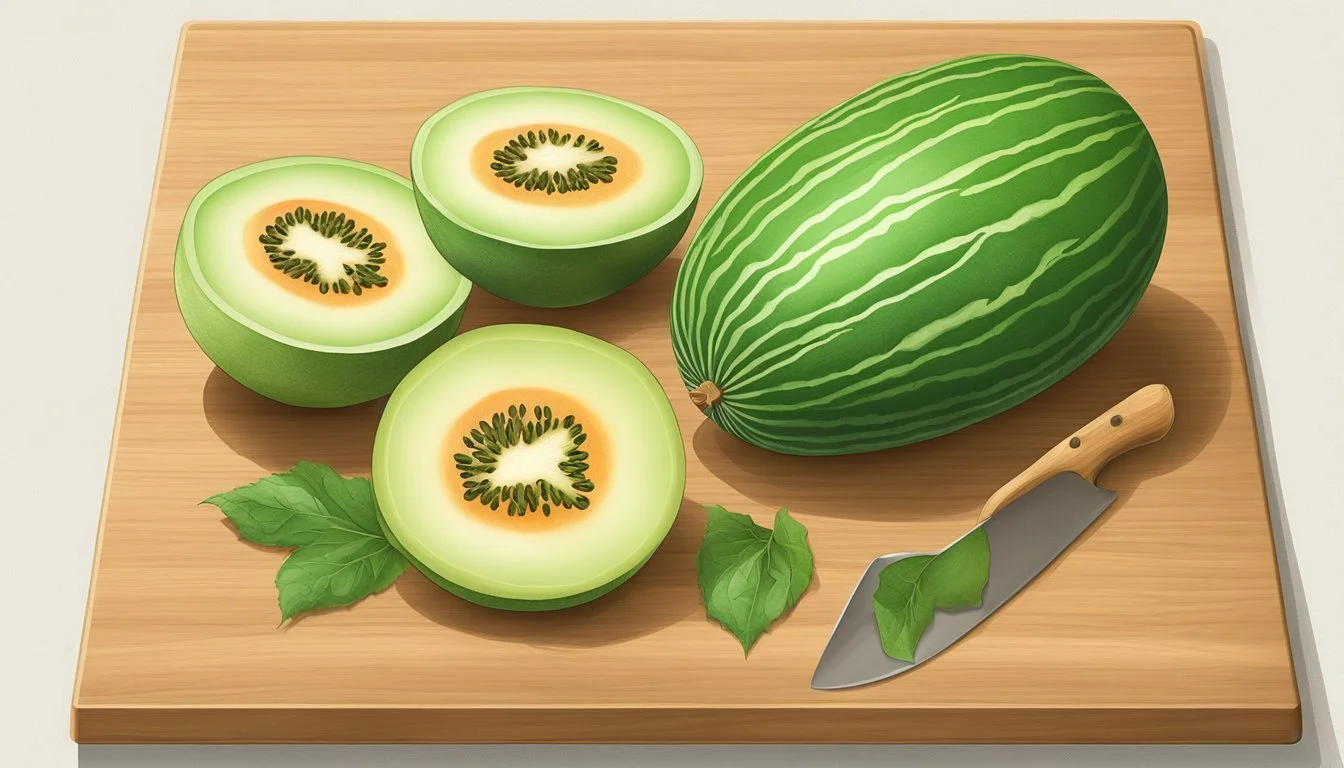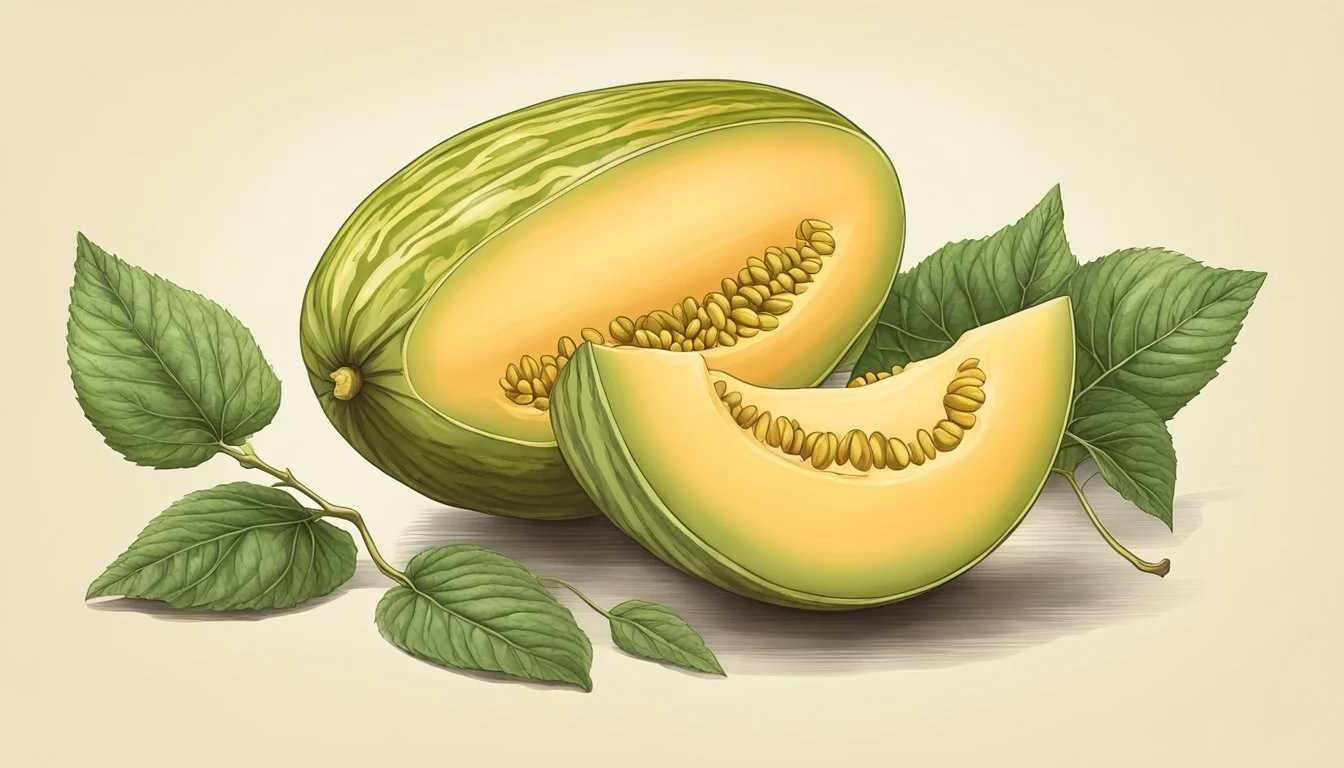How to Tell if a Hami Melon is Ripe
Expert Insights for Perfect Pickings
Selecting a ripe Hami melon is key to enjoying its sweet and juicy qualities at their peak. This variety, originating from China, resembles cantaloupes in its texture and taste characteristics, though it boasts a unique flavor profile that sets it apart. Knowing when a Hami melon has reached its optimal ripeness involves a mix of visual cues, tactile assessments and olfactory signals.
With diverse appearances in color and netting, Hami melons may present a challenge when determining ripeness. The key is to look for a change in the melon's skin tone towards a deep yellow or golden hue, accompanied by a smooth texture. The melon should also feel firm to the touch, yet yield slightly under pressure indicating the flesh inside is ripe. A pleasant, mild fragrance from the stem end of the melon is another sign that it is ready to be enjoyed.
Key Takeaways
A ripe Hami melon has a deep yellow or golden skin tone and a smooth texture.
The fruit should be firm but give slightly under pressure, indicating ripeness.
A ripe Hami melon emits a mild, fruity fragrance from the stem end.
Identifying Ripe Hami Melons
When selecting a Hami melon, it's critical to examine its color, texture, and firmness, as well as to inspect the stem and blossom end for signs of ripeness.
Assessing Color and Texture
A ripe Hami melon generally displays a vibrant yellow color, possibly with thin green lines. The skin should have a smooth texture without any white or brown patches. While color can be an indicator of ripeness, some ripe melons may retain green streaks.
Feeling for Firmness and Weight
A ripe Hami melon should feel firm but not hard, with a slight give when pressure is applied—a sign of juiciness. The melon should also be heavy for its size, indicating that it is full of water and at peak ripeness. Watch for any soft spots, which may suggest overripeness or spoilage.
Checking the Stem and Blossom End
The stem area of a ripe Hami melon may show a subtle seam or crack, signaling that it has detached easily from the vine, which is a natural indicator of ripeness. Additionally, the opposite end, known as the blossom end, should yield slightly to gentle pressure. Avoid melons with spots near the stem or overly soft blossom ends.
Using Your Senses
Selecting a ripe Hami melon involves engaging one's senses to assess its quality. A ripe Hami melon emits a distinct aroma and provides a certain sensation when tasted.
Smell for Aroma
One should sniff the melon near its stem. A ripe Hami melon typically has a sweet aroma, indicative of its readiness to eat. The scent may range from floral to fruity, differing slightly depending on the variety. If the melon has a musky or an unpleasant odor, it may be overripe or spoiled.
Taste and Oral Sensation
A small sample can often convey the ripeness of the melon through taste. A ripe Hami melon should taste sweet with a hint of floral notes. The flesh should feel firm yet yield slightly to pressure. A lack of sweetness or a hard texture indicates that the melon is not yet ripe.
Storing Hami Melons
Proper storage is key to maintaining the quality of Hami melons, whether they're unripe at purchase or ripe and ready to eat. By understanding how to store these melons correctly, one can enjoy their optimal taste and texture for a longer period.
Ripening Unripe Melons
An unripe Hami melon should be kept at room temperature until it reaches full ripeness. As it ripens, the melon's skin will change to a more vibrant yellow, indicating it's ready for consumption. To expedite the ripening process, they can be placed in a paper bag along with ethylene-producing fruits like apples or bananas. The ethylene gas these fruits emit will help hasten the ripening of the melon.
Preserving Ripeness
Once ripe, Hami melons should be stored in the fridge to preserve their freshness. Here is the recommended approach:
Before refrigeration: If the melon is whole, wrap it in cling film to prevent it from absorbing any odors from the fridge.
Temperature: Store the melon at a temperature between 4°C to 8°C (39°F to 46°F).
Consumption timing: A whole, ripe Hami melon can be stored in the fridge for about 5 to 7 days, whereas cut melons should be consumed within 3 days for best quality.
Storage method for cut melon:
Place the cut pieces in an airtight container.
Cover the cut surface with cling film if not consuming immediately.
One ensures their Hami melons are used at their peak flavor and texture through attentive storage practices, be they unripe or ripe.
Understanding Hami Melon Origins
The Hami melon, with its distinct sweet and juicy characteristics, can trace its roots back to the far reaches of the Xinjiang region in China. Despite the fruit's widespread popularity today, it is historically connected to the city of Hami, located in the aforementioned Chinese region. The name "Hami melon" itself is etched from its place of origination.
History:
The history of the Chinese Hami melon is intricately woven with the agricultural practices of the Xinjiang region. Its cultivation extends back centuries, providing not only a source of food but also of cultural significance.
Geographical significance:
Xinjiang region: Known for its arid climate, the region offers ideal conditions for the Hami melon's growth.
Soil composition: Fertile soils contribute to the sweet flavor profile that the melons develop.
Cultivar Classification:
The Chinese Hami melon is a type of muskmelon, which falls under the broader category of cantaloupe. Its variety, however, is distinctly recognized by its oblong shape and crisp texture, setting it apart from its cantaloupe cousins.
By understanding the Hami melon's geographic and historic significance, one can appreciate the rich cultural backdrop against which this fruit has been produced. The Xinjiang region’s contribution to the melon's uniqueness is undeniable, and the melon’s history continues to be nurtured by current cultivation techniques that honor its storied past.
Selecting and Picking the Right Melon
Selecting a ripe Hami melon involves understanding its seasonal availability and recognizing the peak time for harvesting. These factors are crucial in ensuring that the fruit is at its best both for immediate consumption and for achieving a satisfactory yield.
Seasonal Availability and Size
Hami melons thrive in warm climates and benefit from full sun exposure. They require well-draining soil to grow effectively. Seasonally, their availability peaks in summer months, although specific times can vary based on the local climate. When selecting a Hami melon, size can be an indicator of maturity. One should look for melons that feel heavy for their size, indicating a desirable juiciness and sweetness.
Recognizing Peak Harvesting Time
The peak harvesting time for Hami melons is when they display a consistent and vibrant skin color, typically a deep orange or golden yellow. The surface of the melon should be free from bruises and soft spots. Checking the firmness is also important; the melon should be firm with a small amount of give when pressed gently, signaling that it's ripe but not overripe. A ripe Hami melon emits a pleasant and fruity fragrance, indicative of readiness to be picked from the vine.
Health Benefits of Hami Melons
Hami melons, with their juicy and sweet flesh, are not only a refreshing treat but also a nutritious fruit that offers numerous health benefits. Each serving of this delightful fruit contains a modest number of calories, making it a suitable option for individuals who are monitoring their caloric intake.
Nutritional Content
Calories: Low
Potassium: High
Vitamin C: Significant Amount
Fiber: Adequate
Vitamin A: Present
Antioxidants: Contains
These melons are a good source of potassium, which is vital for maintaining healthy blood pressure and proper muscle function. Hami melons provide a substantial amount of vitamin C, crucial for the immune system and acts as an antioxidant, safeguarding the body against free radicals and may reduce the risk of chronic diseases.
Rich in fiber, Hami melons contribute to digestive health, promoting regular bowel movements and aiding in maintaining a healthy gut. The presence of vitamin A within the fruit supports good vision, skin health, and immune function.
The antioxidants found in Hami melons not only support the immune system but also provide a protective effect, contributing to overall well-being and possibly preventing various health conditions.
To summarize, incorporating Hami melons into one's diet can not only satisfy a sweet tooth but also offer a variety of health benefits that strengthen the body and contribute to long-term health.
Incorporating Hami Melons in Recipes
Hami melons, with their sweet and crisp characteristics, lend themselves to a variety of recipes. From refreshing desserts to savory pairings, their versatility is outstanding in the culinary world.
Desserts and Sweet Treats
The Hami melon's sweetness makes it an excellent choice for dessert recipes. One can dice the fruit into bite-sized pieces and add it to a fruit salad, creating a blend with strawberries, apples, and pineapples for a refreshing variety. Another way to delight the sweet tooth is by pureeing Hami melon to craft a smoothie; mix with a touch of lime juice and a few sprigs of fresh mint for a revitalizing drink. For an enhanced flavor profile, incorporate a squeeze of lemon to balance the sweetness with a subtle tang.
Savory Combinations
Hami melon can also be a star in savory dishes. Cheese complements the melon's flavors perfectly, creating an elegant appetizer when paired with cured meats. In salads, Hami melon chunks can add a succulent element, especially when combined with arugula and a balsamic glaze. For breakfast, one could top off a yogurt bowl with Hami melon slices and a drizzle of honey, adding a naturally sweet start to the morning.
Beverage Ideas
Incorporating Hami melon into beverages offers a range of possibilities. Beyond the traditional melon smoothies, one can also create sophisticated mocktails with muddled Hami melon, sparkling water, and muddled fresh mint. For a twist on classic drinks, add Hami melon juice to lemonade to make a melon-infused lemonade that is both hydrating and full of flavor. When using Hami melon in beverages, it's best served chilled to enhance its refreshing qualities.
Practical Tips for Gardeners
Gardeners looking to cultivate Hami melons in a kitchen garden should initially focus on seed selection and planting. Hami melons thrive when grown from seeds that are planted in well-draining soil, ideally during the warm season.
Soil Preparation: Ensure the soil is rich and well-drained. Amend with compost to boost nutrient content.
Planting: Sow seeds directly into the ground in a location that receives full sun for at least 6-8 hours daily.
A gardener should monitor the temperature closely. The ideal temperature range for Hami melons is between 22°C to 28°C. Temperatures above 30°C can impair growth and should be avoided.
As the melons grow, observe the following signs that indicate ripeness:
Skin Color: A rich yellow color with netting indicates ripeness in yellow varieties.
Surface Texture: Ripe melons should have a firm texture but yield slightly to gentle pressure.
Aroma: A sweet fragrance at the blossom end is a strong indicator of ripeness.
Stem Appearance: A drying or cracking stem near the fruit suggests the melon is nearly ripe.
Sound upon Tapping: A ripe Hami melon emits a deep, hollow sound when tapped.
Regularly inspecting the melons and employing these tips can lead to a successful harvest of ripe, flavorful Hami melons in one's own backyard.
Culinary Inspirations from Around the World
Cultivating a ripe Hami melon is an art, appreciated worldwide for its sweet, juicy character, often likened to popular melons such as cantaloupe, honeydew, and muskmelon. Chefs globally experiment with melon combinations, and the Hami melon, with its vibrant orange flesh and sweetness, often finds its place in diverse culinary landscapes.
In California, United States, chefs pair the succulent slices of Hami with prosciutto, emulating the classic Italian antipasto but infusing a hint of Asian essence. The Californian climate, similar to Texas and Washington, also nurtures watermelon and cantaloupe, which sometimes accompany Hami in refreshing summer salads garnished with mint.
Japanese cuisine, always embracing the delicate balance, involves the Hami melon as a prized delicacy. They may serve it alongside other exotic varieties like the Snow melon, offering a spectrum of flavors and textures, from the Hami's gentle sweetness to the Snow's subtle taste.
Korean melon, a mainstay in Korean diets, offers a firmer bite and a slightly different taste. While not to be confused with the Hami, it signifies the variety of melons that inspire culinary creations. In Texas, fusion cuisine might mix Hami melon with mango in salsas or salads, marrying the flavors to complement barbecued meats, (What wine goes well with barbecued meats?) a beloved tradition in the region.
In summary, melons travel well beyond their origins, inspiring dishes from melon balls added to fruit cocktails in California to the garnishes on fine dishes in Japan. The Hami melon, with its sweet appeal, has inspired a global appreciation that resonates in kitchens from east to west, mirroring the cultural fusion that food continually evolves through.






